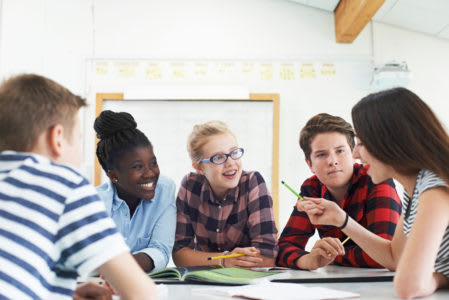It’s not difficult for students to get swept up into situations that require tough decisions, online or offline. Give your students the opportunity to practice their decision-making skills in different situations that surround digital safety, bullying prevention, and character culture with these seven activities.
Digital Wellness
With more and more students becoming active internet users, they must understand the importance of being safe on the web. Digital wellness involves making wise decisions on the internet, limiting the use of technology, and more. Below are a few activities that you can use in your classroom to give your students practice with digital safety.
Activity 1: Speedy Solutions

For this game, display a common digital safety issue (e.g. a student engaging in cyberbullying) on the board. Have your students break into teams and develop different solutions for the problem. Write two options below the issue, with one of the options being the best solution/response to the issue. Give students a minute or two to discuss with their teams which answer they believe is correct. After the time is up, one student on every team has to raise his or her hand the fastest to pick the best option. Whichever team gets the most correct, wins. The competitive yet collaborative nature of this game fosters motivation amongst students to learn about being safe while using technology.
Skill building for: Digital Safety, Collaboration, Critical Thinking
Activity 2: Paraphrasing Partners
Have your students practice paraphrasing and avoiding plagiarism with an activity from the Ignition: Digital Citizenship course, which aims to improve digital wellness amongst students. Lesson plans provides pre-written statements that your students can work together with a partner to paraphrase. You can have students share how they chose to paraphrase a statement with the rest of the class.
3Skill building for: Digital Safety, Writing, Paraphrasing, Communication
Bullying Prevention
Students shouldn’t have to have their education or lives compromised as a result of bullying. According to the National Center for Education Statistics and Bureau of Justice, about 20% of students ages 12-18 have experienced bullying. Help your students rally against bullying in their school community and foster an anti-bullying environment in your classroom with the following activities.
Activity 1: Get To Know You Bingo

Teach students how to find common ground by having them create their own “Get-To-Know-You Bingo” or download and print this pre-made Bingo card. In each square, have students write a fact about themselves. Then have students go around the class and cross off anything they have in common with their tablemates or students. To conclude the activity, ask students to journal about a few unique things they learned or have in common with classmates. This allows them to reflect on the similarities they found amongst their classmates, which may promote friendships or lessen any animosity between students.
Skill building for: Communication, Relationship Building
Activity 2: Capstone Project
EVERFI’s Honor Code – Bullying Prevention program features a Capstone Project you can implement in your classroom in conjunction with the online lessons. For this project, students work to develop a Schoolwide Action Plan to stand up against bullying in their school community. This project helps students take ownership of their school community, learn to be accountable for their actions, and find ways to eliminate bullying together. This could also be the launch of a strong student group for your campus!
Skill building for: Leadership, Collaboration, Communication
Activity 3: Bystander Bylaws
After a lesson on bullying prevention, students may now understand how to be more effective bystanders if they ever witness bullying. For this activity, students should write down a few good things a bystander can do in a situation involving bullying. Allow students to discuss their lists with a partner.
Skill building for: Communication, Creativity
Character Culture
Good character encompasses traits like honesty and integrity, but also conscientiousness when communicating with others and making decisions. By empowering young students with techniques to engage in effective communication and sound decision making, you can ensure that students become effective adults prepared to handle life’s challenges.
Activity 1: Decisions, Decisions
Present students with a scenario and ask them to list the pros and cons of two or more decisions in the scenario. Then ask them to pick the best decision based on their discussion of the pros and cons. This gives them a chance to make decisions about real life issues in a low risk environment.
Example Scenario: Sam is responsible for looking after a younger sibling while their parents are out. But, Sam is tired and wants to take a short nap before going to a piano lesson later that night. Sam’s parents will not be home for another hour. Sam can either take a nap and regain enough energy for the piano lesson, or skip the nap and continue looking after the younger sibling for the next hour. What are the pros and cons of these two decisions, and which decision should Sam make?
Your students can perfect their decision-making in Lesson 6 of EVERFI’s Character Playbook program.
Skill building for: Decision Making, Critical Thinking
Activity 2: Communication Channel Skit
Ask two students to play the roles of ‘Sender’ and ‘Receiver’. Display a scenario that requires effective communication on the board such as:
“The Receiver is talking to a friend in the hallway, but is standing in the middle and the Sender needs to get by. What should the Sender say?”
Then have the Sender choose from pre-written polite or impolite messages like “Excuse me, I need to walk through” or “Move out of the way”. The Sender should choose one and say it aloud. Afterwards, ask the Receiver how they perceived the chosen message. Have different students play each role and choose messages for more scenarios. Ask the students why a certain message is more effective in each scenario. This activity helps students understand that communication is affected by the words, tone, and body language that they use to communicate.
Skill building for: Communication, Relationship Building

